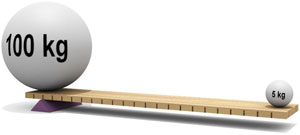
Maths in a minute - levers
Kneeling in the mud by a country road on a cold drizzly day, I finally appreciated the wonder that is a lever. I was trying to change a flat tyre and even jumping on the end of the wheel wrench wouldn't budge the wheel nuts. But when the AA arrived they undid them with ease, thanks to a wheel wrench that was three times the size of mine. There you have it ... size really does matter!

Image by CR
A lever is a truly remarkable device that can literally give any of us the strength of ten men. You can counteract 10 men pushing down on one side of a see-saw by applying just 1/10th of their force, as long as you are 10 times further from the see-saw's centre as they are.
This is because the forces acting on a lever are proportional to the distances they are from the fulcrum. In this way a small amount of force moving a longer distance can move a large load over a smaller distance.
Levers are working hard all around us: in see-saws (where the fulcrum is between the loads), in wheel barrows (where the load is between the fulcrum and the force) and even in our very jaws (where the force is applied between the fulcrum and the load).
Archimedes was the first to mathematically describe how levers work and famously said: "Give me a place to stand, and I shall move the earth with a lever." And give me a long enough wheel wrench and I might just be able to change my next flat tyre for myself!
You can read more about levers from Wikipedia, and more about mechanics and about Archimedes on Plus
math.nights
To Arabic: https://goo.gl/6Jc6yx
S1mplemind
This is like a salesman's claim – only half of the truth. If you exert the equal force of 10 men holding them at bay with a long lever – as long as you are standing still it's true (albeit not comfortable) – your force equals that of 10 guys. But if you want to push them back, you have to go 10x their distance, at full force.